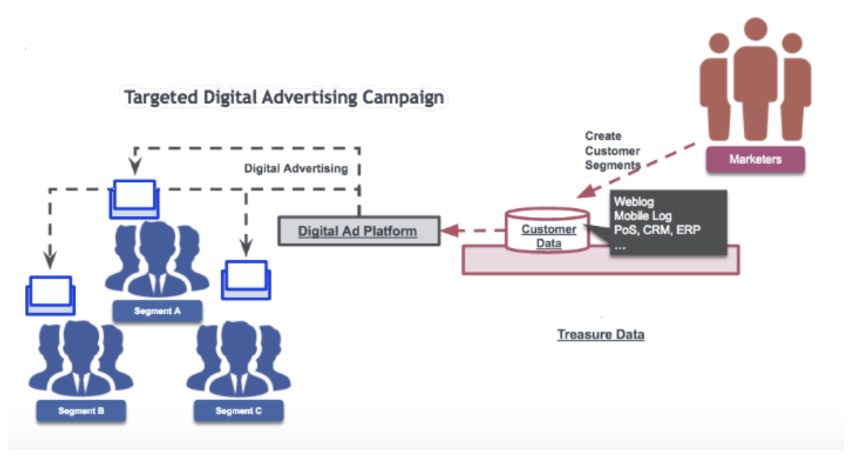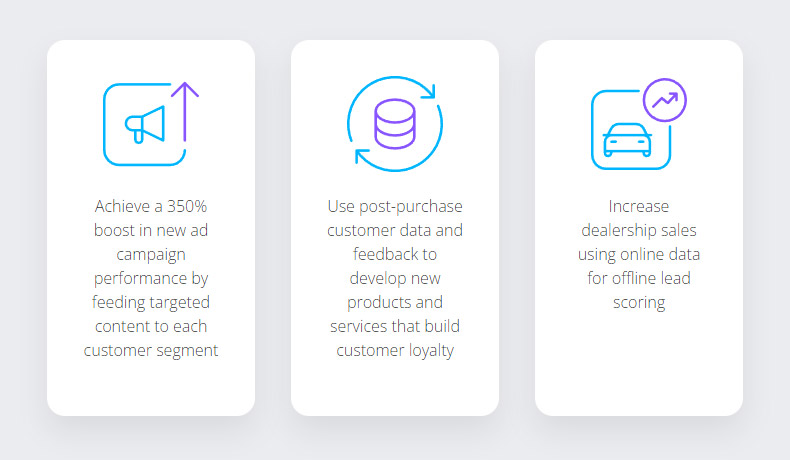Targeting the right customers with the right ads is no small challenge. In fact, according to a recent Gartner survey, 63% of digital marketers acknowledge they struggle to personalize experiences and messaging for customers. A partial cause of this constant struggle lies with marketing leaders who fail to leverage technologies like artificial intelligence (AI) and machine learning (ML) in targeted activities like advertising.
If you can relate to this all-too-familiar friction, here’s some good news: Customer Data Platforms (CDPs) employ AI and ML capabilities that effectively apply customer journey-based advertising and boost ROI while cutting costs. Read on to learn more.
Customer Journey-based Advertising
Customer journey-based advertising aligns marketing actions and messaging to customers’ current stages in their journeys. This approach improves the customer-business relationship by tailoring campaigns and content to ideal customer profiles.
But to apply customer journey-based advertising, one must first understand the customer journey itself.
The customer journey refers to the full lifecycle of a relationship between a business and one of its customers. Rather than focusing on a single transaction or event, the customer journey represents the full duration of a customer-business relationship. This spans every stage or “touchpoint,” from awareness to acquisition, retention, and finally through—when applicable—a final interaction.
Customer journeys fall into four general stages: awareness, engagement, conversion, and post-purchase loyalty/maintenance.

Awareness
At the initial stage of the customer journey, prospects or leads become aware of a company’s product or service. This is often the direct result of lead generation efforts by marketing teams.
At this early stage, the goal of advertising is not to bombard leads with information about the product or service but to tailor ads to catch a prospect’s attention and pique their interest. Brands can also earn prospects’ trust by fine-tuning messaging to convey their status as an authority in their field, a market leader, or an innovative player who brings something new and valuable to consumers. Advertisers and campaign managers can use CDPs to activate boosted posts, display ads, and native ads on channels that attract a high number of leads.
Engagement
The next stage in the customer journey is marked by a lead’s increased interest in learning more about a company’s product or services. Leads may compare a brand to its competitors and seek reviews or use content to inform their purchasing decision.
This stage sees prospects intentionally engaging with intermediate touchpoints and channels. Advertisements therefore should be designed to meet prospects’ immediate need for answers. Brands should be aware of consumers’ top concerns about a particular product or service and use a CDP to deliver relevant ads and links to educational content.
Conversion
Finally, after a series of interactions across channels and touchpoints, the prospect is ready to make a decision. If brands have met their needs and answered their questions, chances are high that the prospect will convert. Yet marketers are keenly aware that many engaged prospects still hesitate before committing to a purchase.
Advertisements at this stage can employ hard-sell tactics to nudge leads toward taking the final step. With the right digital tools, brands can leverage prominent display ads, relevant offers, and timely discounts to reach prospects directly. Using a CDP’s 360° visibility into the customer journey coupled with consumer insight enables brands to predict and seize critical decision-making moments in the journey.
Loyalty
Once customers decide to convert, progressing to the post-purchase stage, brands can focus on maintaining relationships. Teams can leverage ML techniques to analyze other customers’ journeys and learn which actions build loyalty among similar audience segments.
Advertisements at this stage can prompt converted customers to participate in loyalty programs in exchange for points or rewards. Ads for upsell and cross-sell offers can also help increase lifetime value among loyal customers.
How To Use CDPs To Leverage Customer Journey-based Advertising
Treasure Data CDP’s capabilities—like machine learning and predictive analytics—enable brands to anticipate a customer’s next move and plan journey-based advertising strategies accordingly.
Use Treasure Data Customer Data Cloud to:
- Fine-tune targeting for the right audience segments
- Personalize messaging according to customer journey stage OR readiness to buy
- Reach customers on channels and touchpoints with the best chance of success
- Cut costs by deploying targeted ads—only to the right customers
Let’s take a closer look at how CDP solutions like Treasure Data Customer Data Cloud can offer granular analyses of customer segments so brands can better tailor advertising campaigns to ideal customer profiles.
Build Audience Segments
To implement customer journey-based advertising, brands need to know exactly where customers are in their current journey. Treasure Data Customer Data Cloud, an integrated suite of cloud-based customer data platform solutions, centralizes data, unifies profiles, and tracks interactions across channels to provide 360° visibility into customers’ journeys.
This enables teams to build audience segments based on real-time behavior in addition to past actions. Treasure Data Customer Data Cloud can select key attributes, characteristics, and behaviors to segment customers according to their current journey stage. For example:
– First-time web visitors who have not performed key actions
– Engaged web visitors who have visited more than 3 product pages
– Customers who have not visited the website for over 2 weeks after conversion
– Loyal clients with a lifetime value of over $5,000
Teams can further refine segmentation and create more granular segments based on specific actions including real-time activity on brand websites, recent activity on apps, or interaction with IoT devices. This level of analysis enables brands to create extraordinarily precise audience segments for advertising campaigns.
After building audience segments according to their journey stages, teams can then use Treasure Data Customer Data Cloud to send personalized ads and messaging via different segments’ preferred channels and timeframes.

Tailor Advertising
Treasure Data Customer Data Cloud enables campaign managers and marketing teams to activate tailored advertising campaigns according to customers’ current progress. Whether target segments are composed of leads still unaware of the brand or engaged visitors returning to a website, Treasure Data can help you deliver the right ads to the right prospects.

Treasure Data Journey Orchestration identifies audiences along the buying cycle and connects relevant campaigns and channels to consumer behavior. In addition, Journey Orchestration adapts activations according to marketers’ budgets. Teams can choose to target audience segments first with low-cost ads, like email, before deploying higher-cost activations like Google Ads and Facebook.
With Treasure Data Customer Data Cloud, campaign managers and marketing teams can easily orchestrate customers’ journeys to move them closer to conversion. Use it to:
- Automate segmentation and retargeting in real-time to drive conversions
- Track performance of targeted audience segments and profiles
- Follow customers across all connected channels
- Develop and orchestrate customer journeys with drag-and-drop tools
Treasure Data’s suite of customer data platform solutions is designed for scalability. Brands can target thousands of customers in different stages of their journey while making them feel like an audience of one. Subaru is one of the global brands that has leveraged Treasure Data enterprise CDP to cater to different audience segments. Using Treasure Data’s machine learning techniques and predictive analytics, Subaru uncovered key traits between engaged leads who are ready to buy a car and early-stage leads who are likely to wait longer before making a purchase. The carmaker applied these customer insights and boosted its overall advertising ROI by 350% while cutting cost per click by 12%. Read Subaru’s story here:

Predict Behavior
Lastly, Treasure Data Customer Data Cloud helps marketers and campaign managers predict customer behavior to deliver the most effective ads at the right moments.
Using ML techniques and predictive analytics, a CDP can uncover customer insights and predict where key decision points will take place in the customer journey.
What Is Predictive Analytics?
Predictive analytics uses algorithms and machine learning to anticipate future outcomes based on data. A form of predictive modeling, predictive analytics is the branch of big data analytics that is specifically concerned with revealing insights into what will happen in the future based on past occurrences.
Teams can leverage CDPs to anticipate key moments and influence consumers with personalized advertisements to encourage them toward conversion, retention, or engagement according to their particular journey stage.
Treasure Data enterprise CDP also leverages AI-derived insights to predict which segments are most likely to click ads, churn, or convert. Marketers can take further advantage of built-in predictive models within Treasure Data Segment Builder to quickly access and apply insights to customer journey-based advertising campaigns.

Treasure Data Customer Data Cloud enables teams to reuse audience segments to predict behavior and optimize outreach, saving money and time.
Optimize Customer Journey-based Advertising with Treasure Data
Trusted by Fortune 500 and Global 2000 companies around the world, Treasure Data helps marketers and brands apply customer journey-based advertising to boost ROI and cut costs through audience segmentation, personalization, and predictive analytics.
Treasure Data Customer Data Cloud is an integrated suite of cloud-based customer data platform solutions that helps companies improve campaign performance, achieve operational efficiency, and create connected customer experiences. Check out Treasure Data’s CDP tools and features:
Segment Builder – Create segments according to customers’ journey stages and automate updates based on real-time actions on websites. Personalize advertisements, banners, content, and offers to customers on the spot.
Journey Orchestration – Plan journeys at the macro-level to deliver ads personalized to customer journey-based segments at scale
Predictive Scoring – Score profiles in current or new segments to tailor advertising campaigns
Watch how you can use Treasure Data’s suite of customer data platform solutions to optimize ad spend by targeting the right audience according to their customer journey stage:
More About The Customer Journey:
- How to Create Customer Loyalty and Retention With an Enterprise CDP
- Finessing Customer Experience to Promote Revenue Growth
- Top Customer Journey Lead Generations: Tips and Tricks
- Field Guide to Customer Journey Awareness: Understanding Customer Behavior for Better Retention
- How To Maximize Your Customer Insights Benefits for Better Lifetime Value
- How to Use a Customer Data Platform for Better Marketing Strategy
- Weighing Customer Insights vs Market Research to Optimize Your Sales Pipeline
To learn how to leverage customer journey-based advertising with the help of Treasure Data’s CDP, consult an expert today. Want to learn more? Request a demo, call 1.866.899.5386, or contact us for more information.
